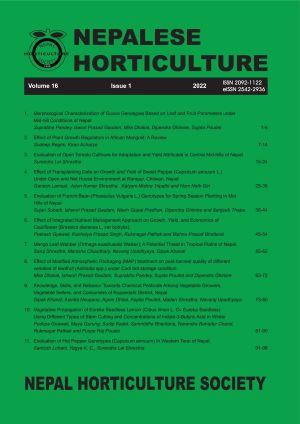Morphological Characterization of Guava Genotypes Based on Leaf and Fruit Parameters under Mid-hill Conditions of Nepal
DOI:
https://doi.org/10.3126/nh.v16i1.44999Keywords:
Breeding, Improvement, fruit, qualitative, quantitativeAbstract
Guava (Psidium guajava L.) popularly known as poor man's apple is one of the common fruit crops cultivated in terai, inner terai and hilly areas of Nepal. There are numerous genotypes available within the country but absence of their proper characterization is impeding guava improvement program The present study was carried out with six guava genotypes (Apple guava, Bangalore, pear shaped, KG-1, Illam Selection and Bari) to investigate morphological characters viz leaf qualitative and fruit qualitative and quantitative characters. The single factor experiment was carried out in randomized complete block design with four replications at National Horticulture Research Centre farm, Khumaltar in the year 2019 and 2020 Four plants of each genotypes were studied which were planted in the year 2015. Four mature leaves and fruits were randomly collected for qualitative characterization and all marketable fruits were collected for the study under mid hill conditions. Among them Apple Guava and KG-1 were found promising due to its attractive fruit shape and size as well as preferable taste and aroma. While observing the fruit qualitative characters maximum fruit length was found in Pear Shaped (71.1 mm) and the minimum was found in Bari (50.2 mm). Similarly, the highest individual fruit weight was observed in Apple Guava (229.5 gm) and the lowest fruit weight was in Illam Selection (59.4 gm). Analysis of variance for different characters showed a high degree of variation among the genotypes. The variability in morphological characters generated valuable information which could be used for a choice of parents for guava breeding programs in the future.
Downloads
Downloads
Published
How to Cite
Issue
Section
License
Copyright (c) 2022 Nepalese Horticultural Society

This work is licensed under a Creative Commons Attribution-NonCommercial 4.0 International License.
© Nepalese Horticultural Society

